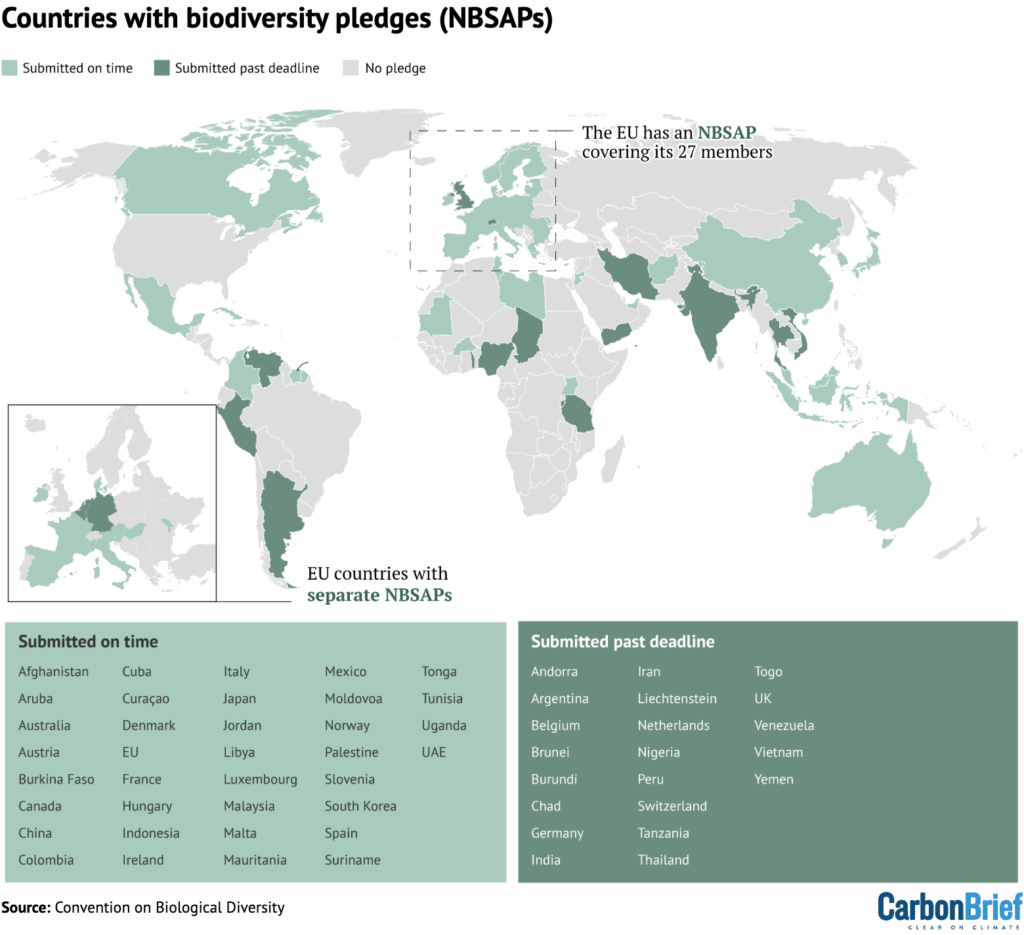Just 28% of countries have met a UN call to submit new plans on addressing nature loss – a year after the original deadline, Carbon Brief analysis shows.
Several of the world’s most biodiverse countries – including Brazil, the Democratic Republic of the Congo and South Africa – are among those that have not yet released their nature plans.
Countries were asked to submit their pledges, known as national biodiversity strategies and action plans (NBSAPs), by the start of the COP16 biodiversity summit in Colombia on 21 October 2024.
After only 15% of nations met the original deadline, countries agreed at the summit to a new text that “urges” countries to release their NBSAPs “as soon as possible”.
Many developing countries have expressed that a lack of available funding has prevented them from publishing their NBSAPs.
A spokesperson for the Global Environment Facility (Gef), the multilateral fund that provides funding to help with the preparation of NBSAPs, tells Carbon Brief that 120 out of 139 countries that have requested financial support since COP16 have been able to access it.
The spokesperson adds that the UN Environment Programme is “working to resolve outstanding issues” to allow the remaining 19 countries to access financial assistance.
Lack of action
In 2022, nations signed a landmark agreement called the Kunming-Montreal Global Biodiversity Framework (GBF), which aims to halt and reverse nature loss by 2030. It is often described as the “Paris Agreement for nature”.
As part of the agreement, countries agreed to submit new NBSAPs “by” COP16, which began on 21 October 2024 in Cali, Colombia. (Countries failed to find agreement on some key issues in Colombia and met again in Rome, Italy, in February 2025 for a resumed session of COP16.)
NBSAPs are blueprints for how individual countries plan to tackle biodiversity loss and ensure they meet the targets outlined in the GBF.
They are similar to nationally determined contributions (NDCs), the plans that outline how individual countries envisage meeting the goals of the Paris Agreement. However, a key difference is that countries are legally obliged to submit NDCs, but not NBSAPs.
The publishing of new NBSAPs was meant to ensure that countries actually implement the targets of the GBF within their borders.
A lack of implementation was widely cited as one of the major factors behind the failure of the last set of global biodiversity rules, the Aichi targets, which were agreed in 2010.
A joint investigation by Carbon Brief and the Guardian found that 85% of countries missed the UN deadline to submit their NBSAPs by COP16.
At COP16, many countries lamented the lack of NBSAP submissions. At the summit, they agreed to a new text that notes the lack of action and “urges” countries to release their NBSAPs “as soon as possible”.
Now, new Carbon Brief analysis reveals that just 28% of nations (55 of 196 parties) have released their NBSAPs – a year after the deadline.
The map below shows countries that submitted their plans to the UN by the 21 October 2024 deadline (light green) and after the deadline (dark green).

Since the original deadline, both Germany and the UK have submitted their NBSAPs. This means that the US, which is not a signatory to the UN Convention on Biological Diversity, is now the only G7 nation without a nature plan.
Eight of the “megadiverse countries” – 17 nations that together provide a home to 70% of the world’s biodiversity – are yet to produce their NBSAPs.
This includes Brazil, the world’s most biodiverse nation and host of the upcoming COP30 climate summit.
The other megadiverse countries that have not yet submitted their NBSAPs are the DRC, Ecuador, Madagascar, Papua New Guinea, the Philippines, South Africa and the US.
The host of next year’s COP17 biodiversity summit, Armenia, is also among those yet to produce an NBSAP.
According to the GBF and its underlying documents, countries that were “not in a position” to meet the deadline to submit NBSAPs ahead of COP16 were requested to instead submit national targets.
These submissions simply list biodiversity targets that countries will aim for, without an accompanying plan for how they will be achieved.
By the end of the COP16, some 119 parties had produced at least one national target. A year later, this figure has risen to 141, or 72% of countries.
Finance flows
At COP16 in 2024, many developing nations said that a lack of timely funding available from the Gef had prevented them from being able to produce new NBSAPs.
In acknowledgement of this, the NBSAPs text agreed at the summit “requests” the Gef to “provide timely support to all eligible parties, aligned with national circumstances and needs, upon request, to enable them” to release their plans.
A spokesperson for the Gef tells Carbon Brief that 120 out of 139 countries that requested financial support have been able to access it, saying:
“Since 2022, the Gef has approved $123.2m in two tranches to support 139 eligible countries through implementing agencies with their NBSAPs updates or revisions. The 138 countries that requested it had access to a first tranche of support of $44.7m.
“Since October 2024, the second tranche of support has been disbursed by UNDP and UNEP to 120 out of the 139 countries that requested it. UNEP is working to resolve outstanding issues and expedite pending disbursements of the second tranche of support for the remaining 19 countries.”
Panama to Yerevan
Country representatives are currently gathered in Panama City, Panama, for preparatory talks for the next UN biodiversity summit, COP17, which will take place in Yerevan, Armenia, over 19-30 October in 2026.
At COP17, the first global review of nations’ progress to achieving the goals of the GBF is set to take place.
This review will draw from the available NBSAPs, as well as national targets and separate national reports, which are due to be submitted by February 2026.
There is little evidence to suggest that the world is on track to meet the GBF’s mission to halt and reverse biodiversity loss in just five years.
For example, an investigation by Carbon Brief and the Guardian published this year revealed that more than half of nations that have submitted NBSAPs do not commit to the GBF’s flagship target of protecting 30% of land and seas for nature by 2030.
The post Analysis: Just 28% of countries have released nature pledges a year after UN deadline appeared first on Carbon Brief.
Analysis: Just 28% of countries have released nature pledges a year after UN deadline
Climate Change
COP30: Spain’s unions say just transition means renewing communities beyond jobs
Unions in Spain are calling for a new just transition strategy that goes beyond plant closures to revive the fabric of life in affected regions, linking public services with jobs and investment.
“When a power plant closes in a rural area, you don’t just lose jobs,” said Manuel Riera of UGT, one of Spain’s largest unions. “You risk losing the life of the place – the families, the neighbours, the school, the bus line. To keep people rooted, we have to rebuild whole economies.”
The end goal is to safeguard workers, diversify rural economies, and keep families rooted.
Spain’s breakthrough: dialogue and territorial pacts
Spain is among the few countries to have managed coal closures through negotiated territorial pacts. Since 2018, 15 agreements have been signed between national, regional and local governments in areas hit by mine and power plant shutdowns. The government also reached tripartite accords with unions and coal companies, guaranteeing solutions for affected workers.
“For the first time, workers and their communities had a seat at the table. It demonstrated that a just transition is possible and that social dialogue with trade unions must be the first step” Riera said. “That gave people dignity in a moment of loss.”
These frameworks funded retraining, supported job-creating projects and ensured public participation. They became an international reference for how social dialogue can guide decarbonisation.
A just transition for renewables: Why COP30 must put people before power
Lessons learned: from energy to social transition
But the experience has also exposed key limits. Job creation alone has not been enough to sustain rural life.
“Again and again we heard: in addition to employment, what decides if families stay is whether there is transport, housing, health care, education,” Riera said. “That is what keeps a territory alive. We have to move from an energy transition to a social transition.”
Judit Carreras Garcia, director of the Instituto para la Transición Justa (ITJ), reflected on the government’s efforts to respond to these challenges:
“Over the years, we have sought to make the just transition a reality through concrete policies and actions — walking the talk through a wide range of measures that include employability schemes, training, funding lines for job-creating business initiatives, just transition energy tender grids, municipal support programmes and environmental restoration,” she explained.
“All of them aim at minimising the impacts of decarbonisation and optimising outcomes based on participation and social dialogue. This effort has come with its own challenges — from managing timing gaps to addressing very different territorial starting points — but our commitment remains firm.”
Both unions and government acknowledge that anticipation is crucial: closures must be aligned with new opportunities, and support must adapt to vastly different territorial realities – from regions facing depopulation to those with stronger infrastructure.


The next phase for just transition
UGT is now working with its federations to shape Spain’s next Just Transition Strategy (2026–2030). Visits to pact areas, including Aragón, where a coal plant closed in 2020, reveal a rising sense of frustration.
“People are tired of waiting,” Riera said. “We have projects on paper, but they don’t see them materialising. Without effective coherent planning, workers retrain and then have to move to Madrid or Barcelona. That is not territorial justice.”
The unions’ demand: keep the territorial approach, but expand it across ministries and sectors, ensuring that services and infrastructure grow alongside jobs.
For Indian women workers, a just transition means surviving climate impacts with dignity
Behind the technical debates lies a deeper fear: the hollowing out of rural Spain, where thousands of villages have already lost their young people and their future. A mishandled transition could accelerate that trend.
“This is not only about jobs,” Riera said. “It is about whether towns survive at all. When a power station shuts, it’s not just the jobs inside the gates that disappear. The bus stops running, the school risks closing, the clinic can’t keep going, housing starts to deteriorate. Families leave, and a town empties. And once they leave, they rarely come back.”
Sharing lessons internationally
In September, Riera met unions from around the world to share Spain’s experience. His message was simple: we must fight for social dialogue and territorial agreements, but these are the beginning — not the end — of a just transition.
“If decisions are only made in the capital, they miss what life is like in a village. What Madrid sees as energy policy, a small town sees as survival: will there still be a bus, a clinic, a school? That is why workers and communities must always be in the room.”
For Riera, the work that goes into the just transition is also a chance to imagine something new.
“We can use this moment not just to protect people from loss, but to renew rural life — to make villages places where families want to stay, where children can imagine their future. This is about dignity, but also about love: love of place, love of community, love of life itself.”
“Water is worth more than lithium,” Indigenous Argentine community tells COP30
A call for Belém – and beyond
Now in Belém for COP30, Riera is bringing a clear message to world leaders: Spain’s experience shows that the just transition must be built from the ground up. The Belém Action Mechanism that has been proposed, he argues, should require cross-sector transition plans – not just energy policies; guarantee participation from workers and communities; and secure public finance capable of delivering not only jobs but the services that sustain life around them.
“The Global South faces the same challenge: how to transition without abandoning people. Without public finance, that is impossible,” he said. “If we treat the just transition as a bargaining chip, we betray them. But if we take it seriously, we can create hope — from Spain to Brazil, from Santander to Belém.”
“This is not only about closing coal or opening renewables,” he added. “It is about whether people can imagine a future for their children. That is what the just transition means.”
The post COP30: Spain’s unions say just transition means renewing communities beyond jobs appeared first on Climate Home News.
COP30: Spain’s unions say just transition means renewing communities beyond jobs
Climate Change
COP30 Bulletin Day 6: COP’s climate march takes to the streets again
Indigenous peoples, climate activists, feminist organisations, clowns, friars, cyclists and more came together on Saturday under Belém’s baking sun for the “Great People’s March”, a demonstration demanding climate justice and territorial protection.
Thousands joined the first march outside the COP venue in four years, as the last three summits were held in Egypt, the United Arab Emirates and Azerbaijan, places where street protests outside the COP venue were not permitted by the authorities.
Week 1 of COP30 ends with uneven progress and many thorny issues still unresolved. Want clarity on what’s at stake? Sign up for our Monday event.
Saturday’s march in Belém ended peacefully at the Aldeia COP, a village designated by the Brazilian government to host the more than 3,000 Indigenous people who travelled to attend the conference.
During the first week of COP, it was mainly Indigenous people who led the two biggest civil society actions: a flotilla sailing on the Amazon River delta on Wednesday and a blockade of the conference centre’s entrance on Friday. Thousands also participated on Saturday.
The props seen at the march included a statue of US President Donald Trump riding on the back of a worker and a figure of Brazilian President Luiz Inácio Lula da Silva using a straw to drink “oil from the Amazon”. A network of green groups dressed in black staged a funeral for fossil fuels, carrying three huge coffins emblazoned with coal, oil and gas.
One of the Indigenous leaders present, Nelson of the Amazon Munduruku people – who organised the blockade of the COP venue entrance – said they were here “to fight, to bring the people’s vindication of resistance and struggle,” and reiterated their demand for a meeting with President Lula.
The soundtrack to the march changed from group to group of marchers, ranging from Indigenous chants and Brazilian music to shouts of Free Palestine and Free Congo.
Adaptation talks held hostage by finance
Finalising a list of 100 metrics to measure progress on adapting to more extreme weather and rising seas after two years of work may have seemed like a relatively straightforward technical win for the UN climate summit in Belém. The COP30 presidency were hoping they might even get it wrapped up in week one of the talks, which winds up on Saturday.
No such luck, as the negotiating groups for Africa, Latin America and the Arab countries have decided they want to use the talks on indicators for the Global Goal on Adaptation as a place to press for more funding from wealthy governments. Earlier in the week, as we reported, they asked for two more years to discuss the metrics, which include “means of implementation” – code for how adaptation will be paid for.
By the mid-point of the talks – when negotiators compile their work into texts that are either ready to be approved or need further refinement by ministers who arrive on Monday – the latest version of the adaptation text was entirely inside square brackets, meaning that none of it has yet been agreed among countries. It will now fall to the presidency to find a way forward.
The text they’ve been handed shows no sign of any convergence of views, and includes two main options on adaptation finance – one which would have nothing at all and the other which reflects developing-country proposals for a new quantitative goal of either $120 billion (from the Least-Developed Countries) or $150 billion (Arab Group) a year by 2030.
Under a current target set at COP26 in 2021, donor governments pledged to deliver at least $40 billion a year by 2025. But with aid budgets being cut by many, current predictions are that they are on track to deliver little more than $25 billion, which leaves a huge gap compared with needs.
Global South’s climate adaptation bill to top $300 billion a year by 2035: UN
Parts of the proposed text released on Saturday also aim to prevent developing countries from being expected to fund their own adaptation measures and say that the indicators would be voluntary and left to countries to decide how to use them, in a bid to avoid being told what they should do to make their agriculture, water and health systems and other infrastructure more resilient.
Debbie Hillier, Mercy Corps’ UNFCCC policy lead, noted that the new text brings together the full spectrum of positions raised by negotiators. “The large number of options and brackets underscores how much work still lies ahead and how crucial ministerial engagement will be in resolving the core political divergences,” she said.
She pointed to the reference to providing at least $120 billion in adaptation finance for developing countries as a signal that “pressure is mounting for a serious response to the scale of adaptation needs,” adding that the text “recognises the urgency of delivering additional and predictable public finance”.
On Friday, African Group of Negotiators Chair Richard Muyungi told Climate Home News that a two-year extension of discussions on the metrics may not be needed if there is political will to unlock more funding for adaptation.
“[If] we get the means of implementation in the indicators, I think we’ll be able to agree [them] within the shortest time possible,” he added.
While adaptation finance has erupted as an issue in the discussions on the metrics, negotiators on this track don’t actually have a mandate to decide finance matters. That is why the hot topic of whether and how to set a new target is also part of talks on the broader finance goal (NCQG) that was decided in Baku last year.
Sources told Climate Home News it may be more likely that adaptation could be allocated a share of the $300 billion a year developed countries agreed to mobilise for poorer nations by 2035 under the NCQG.


Future of $1.3-trillion roadmap uncertain at COP30
COP30 President André Corrêa do Lago today hosted a much-anticipated event on the Baku-Belém Roadmap, a document building on last year’s finance COP. It is meant to chart a way forward to meet a new goal to deliver $1.3 trillion-a-year for developing nations by 2035. But experts said the session failed to provide clear guidance and raised concerns that the roadmap could die in Belem.
The event, which is not part of formal negotiations, was originally scheduled for Tuesday but got pushed back to the weekend after countries failed to decide whether to start a conversation on finance at COP30.
Seven speakers – among them UN climate chief Simon Stiell – read statements for the first half of the 40-minute event, reiterating the roadmap’s main points — a shopping list of measures that could deliver the $1.3 trillion. A handful of governments and observers gave mostly positive feedback.
Ali Mohamed, special climate envoy of Kenya, proposed incorporating its short-term recommendations in the decisions made at COP30. One of those recommendations invites developed countries to consider working together on a delivery plan to achieve the $300 billion they are due to mobilise annually by 2035.
China’s delegate Chen Zhihua told the event that “greater clarity is needed on the implementation path” of that goal.
Corrêa do Lago emphasised that only the $300-billion core goal approved in Baku “is in the process of negotiation” and that the roadmap to 1.3T “is still something open”.
Roadmap to $1.3 trillion seeks to tip climate finance scales but way forward unclear
A representative of Colombia said, on behalf of the AILAC group of Latin American countries, that the report confuses actions to support developing countries with actions to transform all financing flows, and requested to discuss it formally in the UN climate regime.
Some observers were critical of the Brazil-led event at COP30, arguing that it risks leaving the formal negotiations with no clear guidance on finance.
“What happened today was not a conversation. It was not even a format that allows interaction with the presidency,” said Sandra Guzmán, director of the nonprofit Climate Finance Group for Latin America and the Caribbean (GFLAC).
She added that not enough developing countries were represented because at the time climate finance negotiators were in other rooms, attempting to carry the talks forward.
Joe Thwaites, senior climate finance advocate at the Natural Resources Defense Council (NRDC), said the risk of lacking clear guidance is that developed countries could fail to deliver the finance goal, as happened in the past with a previous $100bn goal that was delivered two years late. “I’m really worried that we’re going to be in the same position for the $1.3 trillion, which is a goal 13 times the size,” he added.
Azerbaijani lead finance negotiator Elmaddin Mehdiyev told Climate Home that the mandate to deliver the Baku-Belem roadmap has been completed and focusing on implementation is now “much more important”.
He added that getting the roadmap endorsed or welcomed formally by governments at COP30 was not key to taking it forward as it is a “non-negotiated document”.
Asked about this possibility after the event, Corrêa do Lago told Climate Home News: “There’s a movement starting, but we’ll see how the countries react. I think it’s unlikely to happen in Belém.”


Brazil launches flagship climate and trade forum
The COP30 presidency this Saturday launched a forum for countries to discuss climate and trade, seen by Brazil as one of its “flagship” initiatives outside of the formal talks.
Trade has been one of the most contentious issues at the summit in Belém, after the Like Minded group of emerging economies pushed for an agenda item on the topic at the start of the UN climate talks.
Several countries in that group – among them China, India and Iran – have been hit by US or European trade restrictions such as the recent US tariffs on solar imports. “Collaboration remains the only viable path to solving the global crisis; only through unity can we overcome it,” said Li Gao, China’s head of delegation at the launch event for the Integrated Forum on Climate Change and Trade (IFCCT).
After a week of consultations, countries have yet to agree on whether to hold such a conversation at COP30 and the first reactions to the IFCCT were lukewarm. A senior EU negotiator said on Wednesday that the bloc does not want to address trade disputes at COP that belong in the World Trade Organization.
For now, the Brazil-led forum is in a consultation phase, including on “modalities and thematic focus”, according to its official website. The IFCCT is intended to run for an initial phase of three years from early 2026 to end 2028 and is open for countries to join, it says.
The post COP30 Bulletin Day 6: COP’s climate march takes to the streets again appeared first on Climate Home News.
COP30 Bulletin Day 6: First week ends with a colourful march and much work left to do
Climate Change
DeBriefed 14 November 2025: COP30 DeBriefed: Finance and 1.5C loom large at talks; China’s emissions dip; Negotiations explained
Welcome to Carbon Brief’s DeBriefed.
An essential guide to the week’s key developments relating to climate change.
This week
Finance and 1.5C dominate talks
AGENDA ADOPTED: Negotiations at the COP30 UN climate talks began in the Brazilian city of Belém this week, attended in person by Carbon Brief’s Daisy Dunne, Josh Gabbatiss and Anika Patel. The Brazilian hosts scored an unexpected early win by dodging an “agenda fight” over proposals to add various contentious issues to the official docket. Despite the neat footwork, four issues kept off the agreed agenda – climate finance; emissions reporting; trade measures; ambition and 1.5C – still loom large, having merely been diverted into “presidency consultations”.
PRESIDENCY PROMISES: By Wednesday, the presidency was promising “good news” at a plenary later that day, which had been due to offer an update on progress with the four extra items. Instead, it ended abruptly, with COP30 president André Corrêa do Lago promising to say more at another plenary scheduled for tomorrow. It remains unclear how the presidency intends to deal with these thorny issues, leaving the COP rumour-mill in full swing.
MINISTERIAL MAGIC: Aside from the extra issues, the official agenda at COP30 already has more than 100 items to contend with, including how to track progress on adaptation and how to ensure a “just transition” as emissions-cutting measures are implemented. (You can follow them all via the Carbon Brief text tracker.) While draft texts have started to emerge, many items remain stalled, with persistent divisions along familiar lines (see below). Negotiators will be hoping that ministers arriving over the weekend are primed to unlock progress. Brazil has appointed pairs of these politicians to push for deals in key areas.
Around the world
- Ethiopia has said it will host COP32 after beating out a bid from Nigeria, Reuters reported. Turkey and Australia are still in deadlock over who should host COP31, with a decision due by the end of these talks, BBC News reported.
- China will not contribute to Brazil’s Tropical Forest Forever Facility, Bloomberg reported, while Devex said two multilateral development banks are considering paying in. More than $5.5bn has been pledged so far, which BusinessGreen noted is “well short” of a $25bn target. The fund was labelled a “false solution” by some Indigenous and civil society groups.
- After Brazilian president Luiz Inácio Lula da Silva called for a “roadmap” away from fossil fuels ahead of COP’s opening, rumours are swirling over how this might take shape. A new declaration spearheaded by Colombia and a roadmap with backing from a number of countries, including Denmark, the UK, France, Kenya and Germany, are being floated as possible options.
- China is currently among the countries pushing for “provision of finance from rich countries and unilateral trade measures” to be included on the agenda, reported Climate Home News. Chinese delegation head Li Gao told Agence France-Presse it is “crucial” for developed countries to fulfil their $300bn commitment.
- Dozens of Indigenous protesters forced their way into COP’s blue zone on Tuesday night, expressing anger at a lack of access to the negotiations, Reuters said. On Friday, a peaceful protest blocked the entrance to the blue zone, causing lengthy queues as delegates were forced to use a side door.
344%
The rise in the global use of solar from 2024 to 2035 under “stated policies”, according to Carbon Brief’s analysis of the latest World Energy Outlook from the International Energy Agency.
Latest climate research
- The 2025 Global Carbon Budget, covered in detail by Carbon Brief, finds that CO2 emissions from fossil fuels and cement will rise 1.1% in 2025 | Earth System Science Data
- In its November 2025 update, Climate Action Tracker says that its projections of global warming by 2100 have “barely moved” in four years | Climate Action Tracker
- The AI server industry in the US is unlikely to meet its 2030 net-zero goals “without substantial reliance on highly uncertain” carbon offsets | Nature Sustainability
(For more, see Carbon Brief’s in-depth daily summaries of the top climate news stories on Monday, Tuesday, Wednesday, Thursday and Friday.)
Captured

China’s carbon dioxide emissions have “now been flat or falling for 18 months” since March 2024, analysis for Carbon Brief has found, due, in particular, to the transport, cement and steel sectors. The analysis has been covered widely in publications including China’s Global Times, the New York Times, Financial Times, Reuters, Bloomberg and on the frontpage of the Guardian.
Spotlight
What to expect from COP30 talks
This week, Carbon Brief’s expert team walk through what is happening with the biggest issues being negotiated at COP30.
‘Cover text’
Can you judge a COP by its cover text? At COP, the presidency has the option to pull together a new negotiated “cover text”, an overarching political overview of decisions agreed at the summit, along with other issues not on the agenda that it wants to draw attention to.
COP30 president André Corrêa do Lago might have dismissed a catch-all “cover decision” as a “last-minute solution” ahead of COP and dodged the question since, but other parties have been less shy in hinting that a cover text is, indeed, coming.
Cover decisions are often the product of fraught negotiations, high stakes, too little time and too many parties to accommodate.
This year, there is added pressure to address what is happening in the wider world outside the “negotiations” and to politically signal that the UN climate process is alive and making progress, despite the withdrawal of the US.
What elements could go into it? As a member of the “BASIC” group of nations comprising Brazil, South Africa, India and China, trade measures could find a place. But ideas pushed by Brazilian president Lula for new “roadmaps” away from fossil fuels and deforestation might find a place. Finance, however, could be much trickier to fit in.
Adaptation
One of the key expected outcomes of COP30 is agreement on a list of 100 indicators that can be used to measure progress under the “global goal on adaptation” (GGA). After two years of work by experts, negotiations got underway with a suggested list that had been whittled down from nearly 10,000 possible indicators.
Despite the focus on the GGA by the COP30 presidency and others, division has quickly emerged around the timeline for the adoption of the indicators. The African Group has notably requested a two-year work programme to further refine the list, while other parties are pushing for the indicators to be adopted in Belém as planned.
On Wednesday, an informal note was published that compiled elements for a draft decision. Significantly, for the first time under the GGA, this included a call for developed countries to “at least triple their collective provision” of adaptation finance by 2030, with a target to reach $120bn. This echoed a suggested target originally set out by the negotiating group of least developed countries (LDCs), supported by the African Group, Arab Group and the Association of Latin America and the Caribbean (AILAC) countries.
Just transition and mitigation work programmes
Over the past year, civil society groups have been calling for the establishment of a mechanism to enact the agreed UNFCCC principles of a “just transition”. This gained momentum on Wednesday within negotiations of the just transition work programme (JTWP), when the G77 and China called for the development of the “Belem Action Mechanism” (BAM).
Chile, the Alliance of Small Island States (AOSIS), India and other developing countries supported the mechanism. However, Norway, the UK, Australia and Japan pushed back. Other long-standing points of contention have also raised their heads, including around unilateral trade measures and references to fossil fuels and aligning to global temperature goals.
Within the mitigation work programme (MWP) talks, negotiators are looking to build on two dialogues held this year. The main themes at COP30 are the links between the MWP and the global stocktake (see below) and the future of the programme itself.
Old divisions have emerged in negotiations, focused predominantly on the mandate of the MWP and the potential development of a digital platform as part of its continuation.
UAE dialogue
The landmark outcome of the first “global stocktake”, agreed at COP28 in Dubai, called on all countries to contribute to a “transition away from fossil fuels”. It also mandated a “UAE dialogue” on “implementing the global stocktake outcomes”.
Two years later, countries remain deadlocked over what this dialogue should discuss. Many want it to cover all parts of the stocktake, including the energy transition, while others want an exclusive focus on climate finance. They also disagree on whether the dialogue should have substantive outcomes, including a formal process to keep discussing the issues raised.
Having failed to reach agreement at COP29 last year, the latest draft text shows parties are just as far apart in Belém, nearly halfway into the summit.
Finance
Climate finance for developing countries does not occupy a high-profile position in the formal COP30 negotiations. Yet, as demonstrated by its role in adaptation talks and the agenda dispute, finance still has the potential to derail proceedings.
Ahead of the conference, the COP30 and COP29 presidencies released their “Baku to Belém roadmap”, exploring how finance could be ramped up to $1.3tn by 2035.
An influential group of experts also released new analysis showing a “feasible path” to this goal, leaning on private finance. They said this work would provide a “valuable signal” to those in the finance sector.
However, with no position in the Belém negotiations, it was unclear how – or whether – the roadmap would be taken forward by governments beyond COP30.
Instead, finance negotiators have been occupied with technical matters, but these still show signs of division. For example, some developing-party groups have pushed back against an EU priority goal to extend a “dialogue” about “making finance flows consistent” with climate objectives.
Watch, read, listen
UNDER THREAT: The Bureau of Investigative Journalism told the story of Kim Rebholz – an environmentalist who was threatened for his work curbing illegal logging in Democratic Republic of Congo’s mangrove parks.
SPOTLIGHT ON STARMER: YouTuber Simon Clark has published a video of himself interviewing prime minister Keir Starmer about the UK’s actions on climate and nature, at COP30 and domestically.
INSIDE COP:Outrage and Optimism is running a “special edition” podcast series in partnership with the COP30 presidency, bringing “exclusive, behind-the-scenes access” to the conference.
Coming up
- 14-21 November: UN Climate Change conference (COP30) heads into its crucial second week in Belém
- 15 November: Informal stocktaking plenary of COP30 talks by the Brazilian presidency
- 17 November: Launch of the Global Methane Status Report
Pick of the jobs
- International Energy Agency, intern, China programme | Stipend: €1,000/month. Location: Paris
- Channel 4, sustainability production executive | Salary: £48,125. Location: Bristol, Glasgow or Leeds, UK
- World Bank, environmental specialist | Salary: “GF” grade. Location: Yaounde, Cameroon
- Greenpeace, climate and energy campaigner | Salary: Unknown. Location: Bangkok, Thailand
DeBriefed is edited by Daisy Dunne. Please send any tips or feedback to debriefed@carbonbrief.org.
This is an online version of Carbon Brief’s weekly DeBriefed email newsletter. Subscribe for free here.
The post DeBriefed 14 November 2025: COP30 DeBriefed: Finance and 1.5C loom large at talks; China’s emissions dip; Negotiations explained appeared first on Carbon Brief.
-
Climate Change3 months ago
Guest post: Why China is still building new coal – and when it might stop
-
Climate Change2 years ago
Spanish-language misinformation on renewable energy spreads online, report shows
-
Greenhouse Gases3 months ago
Guest post: Why China is still building new coal – and when it might stop
-
Climate Change Videos2 years ago
The toxic gas flares fuelling Nigeria’s climate change – BBC News
-

 Greenhouse Gases1 year ago
Greenhouse Gases1 year ago嘉宾来稿:满足中国增长的用电需求 光伏加储能“比新建煤电更实惠”
-

 Climate Change1 year ago
Climate Change1 year ago嘉宾来稿:满足中国增长的用电需求 光伏加储能“比新建煤电更实惠”
-

 Carbon Footprint2 years ago
Carbon Footprint2 years agoUS SEC’s Climate Disclosure Rules Spur Renewed Interest in Carbon Credits
-
Renewable Energy4 months ago
US Grid Strain, Possible Allete Sale















